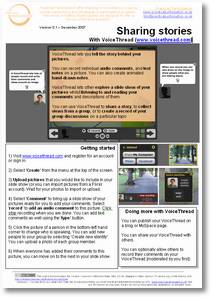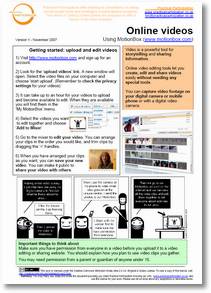I’ve been meaning to post these for a while: six ‘one page guides’ (ok, so actually one of them has two pages..) that I created for the Video Change project with Oxfam.
These are slightly different from the usual ‘one page guides‘ – but hopefully they may prove useful to others running in person or online training around the basics of making video for the web, or about using online video in activism and campaigning.
1) Six Steps to Online Video
An overview guide created to step participants in the course through capture, transfering, editing and uploading their video content.
Step 5 of the guide is specific to Video Change – so would need changing for any other use.
Download the PDF here, or get the original Word Document for editing here.
2) Collecting videos with VodPod
 Whilst we had some problems with getting the VodPod widgets to work properly we did use it in Week 2 of the Video Change course to invite participants to collect and share their favorite videos. There is definitely potential for VodPod as a tool for use by Youth Services and websites to clip and display some of the best positive video clips on the web direct to their websites and blogs.
Whilst we had some problems with getting the VodPod widgets to work properly we did use it in Week 2 of the Video Change course to invite participants to collect and share their favorite videos. There is definitely potential for VodPod as a tool for use by Youth Services and websites to clip and display some of the best positive video clips on the web direct to their websites and blogs.
Again, this guide includes some Video Change specific bits in the ‘challenge’ box – so you download the VodPod PDF here, or download the original word document to update this guide for your own settings.
3) Finding and using Stock Footage
This guide should be generic and ready to do without adaptation and includes five sites to search for creative commons and public domain footage.

So if you regularly try and explain to people how they can use stock footage in their video making you might find it handy and it is ready for download as a PDF here. Of course, you may want to download the MS Word file original and change the list of stock video sources to point to your own favourites.
4) Sharing Videos on YouTube
This one page guide includes tips for upload a video to YouTube and for getting it seen by careful naming of the video and using the playlist, favourite and sharing features.
You can download the PDF here, or get the world file to edit from here.
5) Six approaches to Video Change
 As part of the Video Change course we explored different ways in which campaigners could add online video their the campaigning toolbox. This guide outlines six different ways in which video can be used in activism – from video petitions through to video reporting and using video conversation tools like Seesmic.
As part of the Video Change course we explored different ways in which campaigners could add online video their the campaigning toolbox. This guide outlines six different ways in which video can be used in activism – from video petitions through to video reporting and using video conversation tools like Seesmic.
Get the PDF here, or download the word file for editing and creating your own version.
6) Creating a Sisters on the Planet clip
 The final module of Video Change invited participants to create their own Sisters on the Planet video clips. If you’re running a video making course you could do worse than to set creating a Sisters on the Planet video making challenge to your students – and I’m sure Oxfam would be happy to feature and use some of the resulting clips. This guide is also available to adapt for other video making challenges.
The final module of Video Change invited participants to create their own Sisters on the Planet video clips. If you’re running a video making course you could do worse than to set creating a Sisters on the Planet video making challenge to your students – and I’m sure Oxfam would be happy to feature and use some of the resulting clips. This guide is also available to adapt for other video making challenges.
Get the PDF to use it as it is, and download the word file if you want to play around with it for your own projects.
—–
As with all the one page guides these are all licensed under a Creative Commons license to allow them to be adapted and re-used. However, please do note the request for these guides in particular that if you do find them useful that you credit Oxfam.org.uk and consider making a donation or taking a campaign action from here in return for getting the resources for free.
 [Summary: Handy guide to all the stages of creating a video of a youth project; from selecting equipment and sorting out consent; to planning, shooting and editing your film]
[Summary: Handy guide to all the stages of creating a video of a youth project; from selecting equipment and sorting out consent; to planning, shooting and editing your film] Even with all the amazing social web tools available out there – e-mail remains a key communication tool for most people.
Even with all the amazing social web tools available out there – e-mail remains a key communication tool for most people. [Summary: all the one page guides
[Summary: all the one page guides  I’ve been trying to create a general purpose
I’ve been trying to create a general purpose 





 Tomorrow
Tomorrow  These two
These two  The second guide outlines how you can edit video online using MotionBox. For users whose computer systems are firmly locked down by the corporate or local authority IT department, online editing may well present one of the best options for quickly creating and sharing effective video content.
The second guide outlines how you can edit video online using MotionBox. For users whose computer systems are firmly locked down by the corporate or local authority IT department, online editing may well present one of the best options for quickly creating and sharing effective video content.